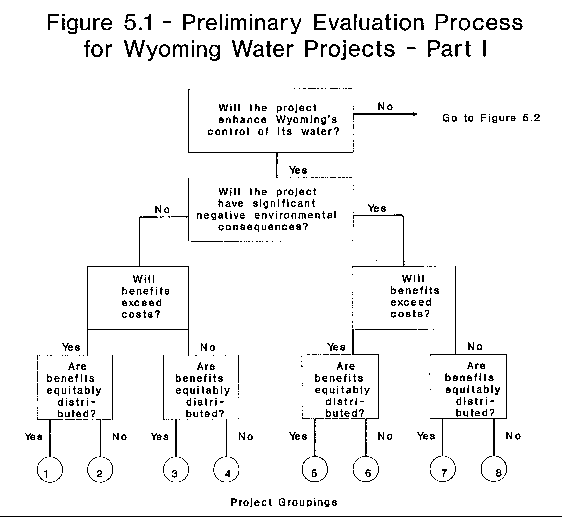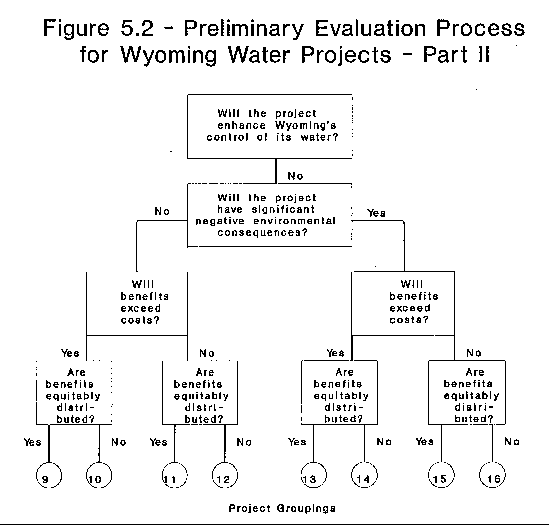| |||||||||||||||||||||||||||||||||||
| |||||||||||||||||||||||||||||||||||
CHAPTER 5
BRINGING IT TOGETHER: A PRELIMINARY METHODOLOGY
5.1 INTRODUCTION
We have argued "that economic efficiency criteria (benefit-cost measures) should be only one element in an appropriate economic evaluation process for Wyoming water projects. In fact, our survey results indicate that two other issues are significantly more important to Wyoming residents than the issue of economic efficiency. A rank ordering of issues from the survey in terms of their relative importance is given below:
This section of the report presents a preliminary methodology for incorporating all four of these issues into a multiple objective planning (MOP) framework for the evaluation of Wyoming water projects.
5.2 OVERVIEW OF THE METHODOLOGY
To incorporate non-efficiency criteria into the evaluation process, a method must be devised of assigning different values to various projects according to those criteria. For example, values could be assigned on an infinite numerical scale, as is the case with benefit-cost measures. At the other extreme, something as simple as a dichotomous split into "acceptable" and "unacceptable" categories on each project attribute could be employed. With respect to Wyoming water projects, we see no need and many perils to assigning continuous numerical scales to such issues as all of a project's environmental consequences. Doing so would not only be time consuming and expensive, but would tend to obscure the underlying criterion for acceptability on each issue.
In fact, there is relatively little need for a continuous numerical scale with respect to a Wyoming water project's economic efficiency (benefit-cost ratio). As discussed in Chapter 2, benefit-cost measures compute benefit-cost ratios on a continuous scale because the ratio acts as a "trigger" to indicate that funds should be shifted from one sector of the national economy to another. As a practical matter, however, the Wyoming Water Development Program has a fixed source of revenue established by legislation in the form of severance taxes, and a list of projects proposed for funding that would more than exhaust those revenue sources if all were funded. In that context, the relevant question becomes more one of which projects meet acceptable criteria for construction, as opposed to whether more state money should be diverted for water development.
For that reason, and to avoid overcomplicating our preliminary specification of the methodology, we have employed a dichotomous evaluation criterion for each of the three non- efficiency issues we have identified with respect to Wyoming water projects. That is, we developed preliminary criteria that will be used to categorize a project as "acceptable" or "unacceptable" according to each of the three issues. These dichotomous evaluations were then incorporated into a multi- objective planning (MOP) framework depicted by the decision tree in Figures 5.1 and 5.2. As those figures show, the overriding economic issue concerning water project evaluation is whether the project will enhance Wyoming's control of its water resources. Projects that put water to beneficial use, or store water for foreseeable future beneficial use, have this characteristic. The next most important question is whether the project will have significant negative environmental consequences, followed by the question of whether efficiency benefits exceed costs. The distribution of project benefits becomes the final element in the evaluation process.
Using the approach depicted in Figures 5.1 and 5.2, it is obvious that the "best" Wyoming water projects are those that


enhance the state's control of its water resources, do not have significant negative environmental impacts, have benefits in excess of costs, and provide for an equitable distribution of project benefits. Projects that meet these criteria have been labelled as Group 1 projects in Figure 5.1. The next best projects, labelled Group 2, have all of the characteristics of Group 1 projects except that they provide for a less equitable distribution of project benefits. Projects in Groups 3 and 4 have similar characteristics to those in Groups 1 and 2 except that efficiency benefits do not exceed costs for those projects.
Projects in Groups 5 through 8 have characteristics similar to those in Groups 1 through 4 except they have significant negative environmental consequences. Finally, projects in Groups 9 through 16 are similar to projects in Groups 1 through 8, except that they would not significantly enhance Wyoming's control of its water resources.
Before the evaluation procedure depicted in Figure 5.1 can be implemented, a set of criteria must be developed for classifying projects as "acceptable" or "unacceptable" with respect to each issue. That topic is discussed in Section 5.3 below.
5.3 NON-EFFICIENCY CRITERIA
It should be noted that the dividing line between an "acceptable" and "unacceptable" rating will always be subjective, and thus will likely provoke arguments about how a project should be classified. Such controversy is inevitable with any type of ranking system. The criteria suggested here, although preliminary and subject to revision, should at least help keep debate focused on those issues which are relevant to the decision making process:
5.4 INTEGRATING THE METHODOLOGY WITH EXISTING PROCEDURES
The Wyoming Water Development Commission (WWDC) currently uses a three-level approach for the evaluation and construction of water projects. Level I studies typically involve an analysis of development options and a description of the physical, legal, technical, economic, and environmental constraints that may affect project development. Level II studies involve a more detailed engineering and economic analysis of the project, and those projects that are deemed feasible at the end of Phase II are recommended for Level III construction funding (see Chapter 1, Section 1.2).
With respect to the evaluation process described in Figures 5.1 and 5.2, a preliminary evaluation of a project's acceptability with respect to the control and environmental issues could be made during Level I studies. A Level I determination that a project would both enhance Wyoming's control of its water resources and not harm environmentally sensitive areas would result in the project being classified in Groups 1 -through 4 on the ranking scheme depicted in Figure 5.1. Such projects would receive the highest ranking possible for a Level I study, and should be recommended for Level II study.
At the opposite end of the spectrum are projects that would not enhance Wyoming's control of its water resources and would have serious negative environmental consequences. Such projects (Groups 13-16 in Figure 5.2) should seldom, if ever, be recommended for Level II study.
Projects that fall into the middle groupings (Groups 5-12 in Figures 5.1 and 5.2) should be considered for Level II funding only on a case-by-case basis. Some projects in these groups may involve a trade-off between significantly enhancing Wyoming's control of its water resources and at the expense of environmental damage to wild and scenic areas. In such cases, Level II studies may need to weigh these trade-offs using the contingent valuation method or other non-market valuation techniques. In general, however, projects in the middle grouping would not be forwarded for further study unless there is significant uncertainty about their environmental consequences and/or ability to enhance control.
During Level II studies, a determination of efficiency benefits and the distribution of those benefits should be made. Thus, at the completion of Level II studies, a determination should be made concerning whether the project falls in Group 1, Group 2, Group 3, or Group 4, or lower. (A more detailed evaluation of the project's environmental consequences and its ability to control Wyoming's water resources would also be undertaken during Phase II, and may result in the project being downgraded after further review.)
5.5 SUMMARY
Referring back to Figure 1.1 in Chapter 1, it is obvious that there are so many factors involved in water project evaluations that no set of criteria will ever be accepted by all those involved in the decision making process. Special interest groups will always have their input, which might be quite different from the economic well-being of the state as a whole. Thus, while we do not believe the methodology proposed in this section will end the debate about Wyoming water project evaluations, we believe it will focus that debate on the issues of importance concerning Wyoming's water resources.
The methodology described above is preliminary; i.e., much more needs to be done to define the criteria described in Section 5.3, and the methodology needs to be refined through application to a series of historical projects to determine its usefulness in segregating "acceptable" and "unacceptable" water projects from the Wyoming perspective. That topic is discussed further in Chapter 6 of this report.
90-12 Table of Contents
Water Resources Publications List
Water Resources Data System Library |
Water Resources Data System Homepage